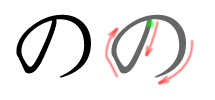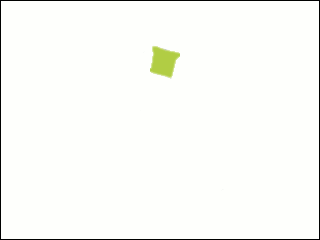______________________
Today’s character is NOBITA!
Kaoko: Let's introduce our guest on today's lesson, here is NOBITA NOBI
Nobita: Ah, uh, こんにちは (Hello)!I'm Nobita Nobi (のび太野比), yoroshiku onegaishimasu (nice to meet you) !

Tna: Ara? Nobita-kun ka? Why are you here?

Nobita: Doraemon told me to go here. I don't know what's going on actually, but he said Shizuka-chan is here! Where's she? Where's she?
Tna: Shizuka-chan?


Nobita: Yeah, but why I don't see her??? Ano yarou, he must be deceiving me!

Tna: Oi, Nobita-kun, listen to me! I think there are some misunderstandings
 . I asked Doraemon to help us teaching today's lesson with some tools from his yōjigen-pocket (fourth dimensional pocket). But why did he send you here instead?
. I asked Doraemon to help us teaching today's lesson with some tools from his yōjigen-pocket (fourth dimensional pocket). But why did he send you here instead? 
Nobita: Doraemon? Teaching? He sent me? .... That means I replace him as a lecturer?
 NOOOOO~ !!
NOOOOO~ !!*Nobita's ready to run away, but Kaoko blocked on his way*
Kaoko: Shikata ga nai yo (it can't be helped). Since you are here already, you should do something!

Nobita: Me? Noooooo~

Kaoko: Hey, Nobita-kun, since your name begins with ’の’, maybe you can do something
 ... Nee, Tna-chan?
... Nee, Tna-chan?Tna: Sou, sou. Well, Nobita-kun, please write your name on the board!

Nobita: Ano...

Kaoko: Ara? Doushita no (what's the matter), Nobita-kun?
Tna: You do know how to write your name, right?
Nobita: Eto... Ahahaha, yes sure! *cold sweat*
*Nobita walked to the board and tried to write down his name*
のび太 (のびた) 野比 (のび)
Kaoko: Good. Now please write down ten things begun with ’の’!
Nobita: Na-na-na-nani??!! (What?!)

Tna: What's wrong?
Nobita: Ah~ Ahehe iya (nope)... But mind if I go to the toilet first? *scratching head*
Tna: Dou, Kaoko-chan? (How’s, Kaoko-chan?)
Kaoko: Well, don't take too long!
Nobita: Arigatou~
Nobita immediately stepped out the classroom and he ran away to the opposite direction of toilet.
Tna: Ano yarou! Nigeta wa yo aitsu! ~ (He ran away!~)
Kaoko: Mattaku
 Maa, I think we should continue our lesson without them...
Maa, I think we should continue our lesson without them...Tna: Sou desu ne...
______________________
Pronunciation:
‘の’ is romanized ‘No’.
Words with ‘の’:
‘の’ at the beginning:
- 伸ばす / のばす ([no]basu -> strecth; extent; lengthen)
- 上る / のぼる ([no]boru -> climb; rise; ascend; go up)
- 乗せる / のせる ([no]seru -> to place; mention; accommodate)
- 望む / のぞむ ([no]zomu -> hope; desire; wish)
- 農夫 / のうふ ([no]ufu -> peasant)
- 飲む / のむ ([no]mu -> drink)
- 残る / のこる ([no]koru -> remain)
- 残す / のこす ([no]kosu -> leave)
- 脳味噌 / のうみそ ([no]umiso -> brains)
‘の’ in the middle:
- ありのまま (ari[no]mama -> truth; actually)
- 絵具 / えのぐ (e[no]gu -> paint)
- 火のし / ひのし (hi[no]shi -> to fire)
- 昨日 / きのう (ki[no]u -> yesterday)
- 彼女 / かのじょ (ka[no]jo -> she; girl friend)
- 命 / いのち (i[no]chi -> soul; life)
- 祈る / いのる (i[no]ru -> pray)
- 不能 / ふのう (fu[no]u -> inability; impossibility)
- 実り / みのり (mi[no]ri -> fruit)
‘の’ at the end:
- あの (a[no] -> that <far from the speakers and the listeners>)
- どの (do[no] -> which)
- 附帯の / ふたいの (futai[no] -> incidental)
- 干物 / ひもの (himo[no] -> dried fish)
- この (ko[no] -> this)
- その (so[no] -> that)
- 帆の / ほの (ho[no] -> sail)
- 食べ物 / たべもの (tabemo[no] -> food)
- 飲み物 / のみもの (nomimo[no] -> beverage)
‘の’ as Particle:
When nominalizing whole phrases, the no may function either as emphasis or as a question, depending on tone of voice. Similar to English, a falling tone denotes a statement, and a rising tone a question. Its use to mark statements tends to be more typical of feminine speech.
‘の’ as Possession Particle
- 私の携帯 / わたしのけいたい (Watashi no keitai -> my celullar phone)
- 車のトヨタ / くるまのとよた (Kuruma no Toyota -> Toyota the car (company))
- 彼の作ったケーキはおいしかった / かれのつくったけえきはおいしかった (Kare no tsukutta keeki wa oishikatta -> The cake he made was tasty)
‘の’ as Verb (normalization)
- 読むのが大好き。/ よむのがだいすき。(Yomu no ga daisuki -> I love reading)
‘の’ as Phrases (normalization)
- もう、食べたの?/ もう、くるまなの?(Mou, tabeta no? -> Have you already eaten?)
- 辞書なの?/ じょしょなの? (Jisho na no? -> Is it dictionary?)
- 彼にもうあげたのよ!/ かれにもうあげたのよ!(Kare ni mou ageta no yo! -> I already gave it to him!)
Stroke order:


______________
Task: You shall write ‘ね’ 50 - 100 times in your textbook. And remember! Memorize the shape, the stroke order, the sound, the pronunciation (echo the sound of the character each time you write it down), etc.
And after you are done with that, write ‘な’, ‘に’, ‘ぬ’, ‘ね’ and ‘の’ one after each repetitively (な, に, ぬ, ね, の etc.) 50 times (100 if you have time).


^^ Welcome back, Kaoko-chan! I've been waiting for your lesons! Yay! Thank you for being active again.
ReplyDeleteNext time, who will be your guest? I hope it's not Conan-kun. lmao.
@Nga: You are very welcome, Nga-chan! Thanks a lot for welcoming me back :D I was happy reading your comment.
ReplyDeleteIn the lesson HA. We choose: Hakuba, Haibara, and Hatake Kakashi. We've done lesson HI with Hinata from Naruto as a guest. And lesson FU with none xD
As for lesson HE, we are thinking if we could use Heiji xD
Haha, of course not. The kana for Conan-kun already past. I am thinking if I should use him in Katakana KO, haha. :D Why, you don't like Conan? See you around later, my friend! We'll try our best to finish Hiragana as soon as possible so we can go on to next adventure :)
Be sure to be with us till then!